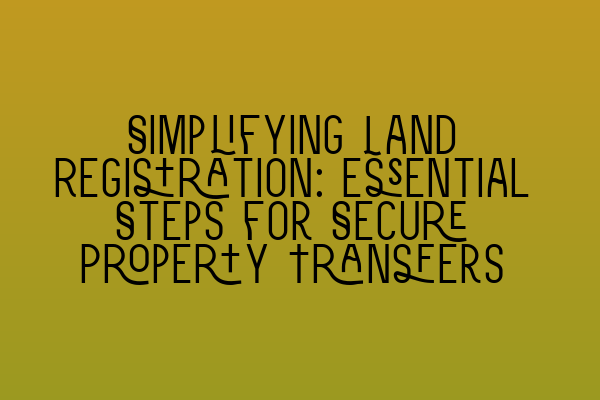Simplifying Land Registration: Essential Steps for Secure Property Transfers
At SQE Property Law & Land Law, we understand the importance of secure property transfers. When buying or selling property, ensuring seamless and efficient land registration is vital for both parties involved. In this blog post, we will guide you through the essential steps for simplifying land registration and achieving secure property transfers.
The Importance of Land Registration
Before we dive into the steps, let’s first understand why land registration is crucial. Land registration provides a legal record of property ownership, boundaries, restrictions, and any encumbrances. It helps prevent disputes, protects property rights, and ensures the validity of property transactions. By simplifying land registration, we can streamline the process and enhance the security of property transfers.
Step 1: Conduct a Title Search
The first step in the land registration process is conducting a title search. This involves reviewing the property’s title and any relevant documents to verify ownership and identify any existing encumbrances, such as mortgages, liens, or easements. A comprehensive title search can help identify potential issues that may affect the property transfer and allow for necessary actions to be taken.
If you need guidance on conducting a title search, refer to our article on Understanding Contractual Capacity: Rights and Limitations.
Step 2: Ensure Clearing of Encumbrances
Once the title search is complete, it is essential to address any identified encumbrances before proceeding with the property transfer. This may involve paying off outstanding debts, obtaining necessary releases, or renegotiating terms with the parties involved. Clearing encumbrances ensures a clean transfer of property and provides peace of mind to both the buyer and the seller.
If you want to test your knowledge on contract law, take our Interactive SQE Mock Tests for Contract Law and enhance your understanding.
Step 3: Prepare and Execute the Transfer Document
Once the title is clear of encumbrances, the next step is preparing the transfer document. This document, typically a deed or contract of sale, outlines the terms and conditions of the property transfer. It includes details such as the parties involved, the purchase price, and any additional provisions or warranties. Both the buyer and the seller must review and sign the transfer document, ensuring their agreement to the terms and conditions.
Join our SQE Contract Law Webinars to gain expert insights and guidance on a range of legal topics.
Step 4: Submit the Transfer Document for Registration
After executing the transfer document, the final step is to submit it for registration at the appropriate land registry. This process involves paying the necessary fees and providing all required supporting documents. Once registered, the transfer document serves as evidence of the property transfer and legally binds the new owner to the property. It is essential to ensure that the transfer document is accurate and meets all legal requirements before submission.
For an analysis of recent changes in contract law, refer to our article on Contract Law Reforms.
Final Thoughts
Simplifying land registration is essential for secure property transfers. By following these essential steps and ensuring compliance with legal requirements, both buyers and sellers can have confidence in the validity and security of their property transactions. At SQE Property Law & Land Law, we are committed to assisting you throughout the land registration process and providing comprehensive legal advice for all your property law needs.
If you want to understand the rights and responsibilities of parties in a contract, our article on Parties in a Contract: Rights and Responsibilities will provide valuable insights.
